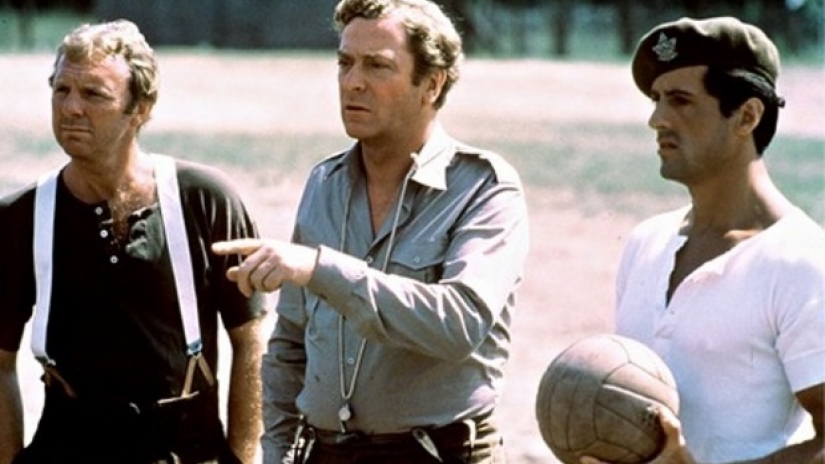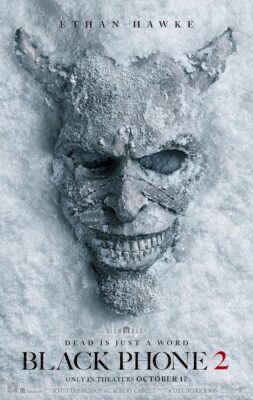It is the middle of the night. A prisoner tries to escape from a World War II camp. He’s caught in barb wire. Sentry dogs bark as spotlights find him. Soldiers shoot him on sight. The drums and trumpets of Bill Conti’s soundtrack introduce the credits. Who could have imagined that the great John Huston would direct Sylvester Stallone in a soccer-war-escape film. I would like to tell you that “Escape to Victory” (aka “Victory”) has the drama of the World Cup tournament with the feel of the Dirty Dozen, but it doesn’t. I’d like to tell you that this 1981 film provides strong social commentary, daring to hold the secrets to world peace, and maybe it does. Or not. Still, it’s a loveable, simple movie chronicling some prisoners of war dueling a Nazi superteam.
Major Karl Von Steiner (Max Von Sydow) recognizes a former soccer star like himself among the prisoners, British Captain John Colby (Michael Caine). They have an idea to organize a “friendly,” an exhibition soccer match between the Nazis and the incarcerated. Meanwhile, in the same camp, American Captain Robert Hatch (Stallone) monitors the movements of the guards as he plots his escape. Somehow, the greatest soccer player of his era, Pelé, arrives and joins.
These two threads—one of sports and the other of war—converge in the final act with a climactic match. You can assume that Sylvester Stallone saves the day, but even though I’ve seen this movie dozens of times—as recently as last week—I don’t remember who wins. I do, however, remember the soccer.
Can a sport ever overtake the global love that soccer has? Michael Jordan and the American marketing machine brought basketball to the world. The dribbling in basketball has a beauty that rivals the dribbling of soccer. Basketball also has the quickness that a modern media-consuming audience, myself included, thirsts for. But, soccer has simplicity. Because the scores are so low, soccer has suspense. Further, soccer has the rivalry of two teams, yet when the scorer approaches the net, it is a one-on-one competition between the shooter and the goalie.

There are two moments in the film that I replay in my mind, still nearly forty years after the film’s release. In one, as the ball descends toward him, Pelé jumps up and flips over his back for a perfectly executed bicycle kick. In another, Osvaldo “Ossie” Ardiles grabs the ball with his feet, and taps it from behind his back, over his head, in front of him, in a rainbow. Spike Lee’s “He Got Game” has some beautiful basketball moments. Barry Levinson’s “The Natural” has some beautiful baseball moments. Still, the only sport other than soccer that has such grace in slow motion is horse racing, recalling scenes at the end of “The Black Stallion.”
Today we celebrate our athletes in the way we used to celebrate war heroes, with giant parades. I was by accident caught downtown in the 2016 celebration of the Chicago Cubs world series victory. I was meeting a friend for breakfast, we scheduled the meeting a week or two prior. I get on the train that morning, and everyone was dressed in blue. The last time I saw so many people crowding together, where the crowd was larger than what my eyes could register, I was in Mecca for the pilgrimage, though without all the alcohol. I suppose that is a fitting analogy, because sports can be religion for many, and religion can be sport for many.
We see contrast in this film, not between sport and religion, but between patriotism and nationalism. In championships, we root for our own team and share in their victory or loss. In war, regimes fill their populaces with nationalist pride (rather, rage), so as to justify the bloodshed of villains.
We depicted the Nazis and Soviets this way. Now, we depict China and Muslim-majority nations like Saudi Arabia this way. In 2018, something has shifted: Saudi Arabia grants driver’s licenses to women and screens American movies in modern cinemas while we are walling ourselves in from the “infestation” of illegal immigrants, refugees, and asylum seekers.
I am old enough to remember a time in our American history when politicians and their followers would not equivocate on references to the Nazis. Today, leaders take moments to explain why their policies are not like the Nazis. That was a time when camps of detainees were empty haunted museums preserving an evil past that could never again happen. They were fossils showing us that we had evolved. Most important, despite our own history with the Native Americans, the Transatlantic Slave Trade, and the Interment of the Japanese Americans, the Nazi was a foreign villain. Things are different today: it is as though many in our society have merged patriotism and nationalism, taking such offense at any criticism of our nation—even from veterans—they excommunicate them as disloyal threats.
There is another discussion in the film, where Michael Caine demands the Nazis give his squad quality uniform, training, and equipment for his players. Such is war: uniform, training, equipment. Both sport and war involve men seeking heroic victory. Perhaps the “victory” in this film, however, is not in the final score. In the climax, all the screaming fans leave their seats and swarm the field, then they break out of the stadium. Perhaps the victory is when the athletes took off their uniforms and, like the others, escaped as mere mortals.












